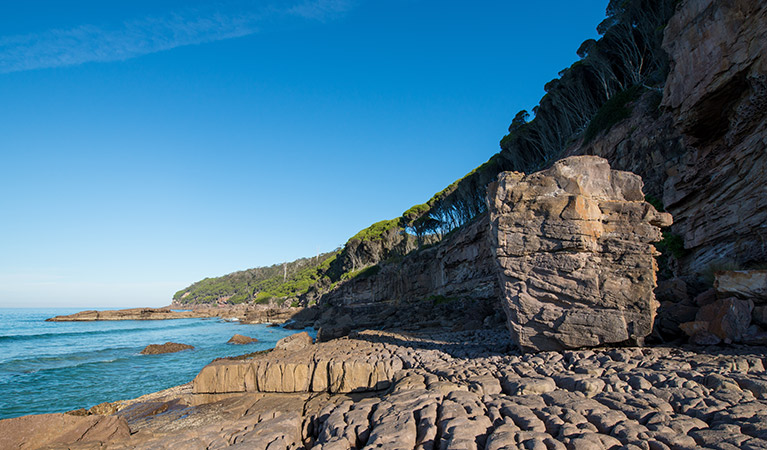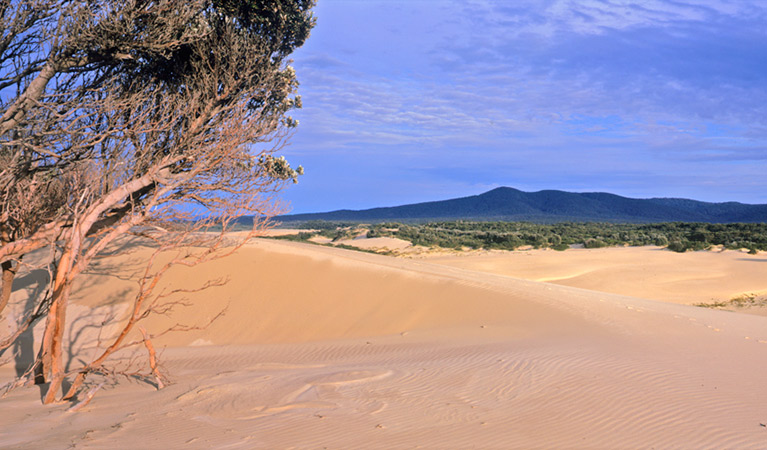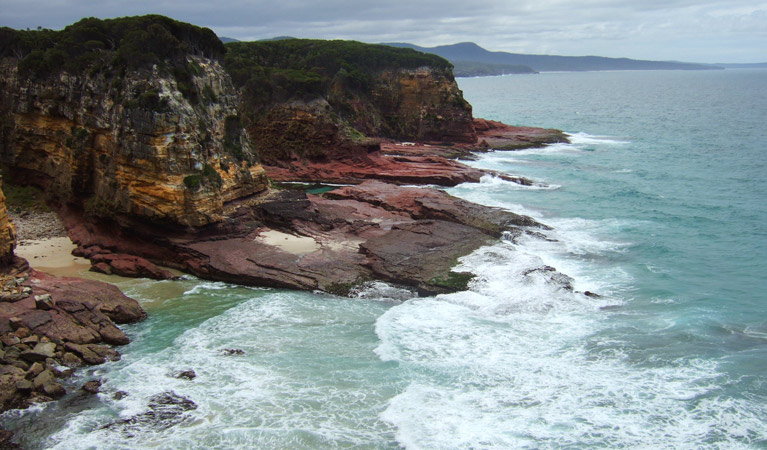Nadgee wilderness walk
Nadgee Nature Reserve
Overview
Nadgee wilderness walk is a spectacular 55km walk from Merrica River to Mallacoota, with coastal views. It's great for birdwatching, whale watching and camping.
- Where
- Nadgee Nature Reserve in South Coast
- Distance
- 55km one-way
- Time suggested
- 3 - 4 days
- Grade
- Grade 5
- Trip Intention Form
-
It's a good idea to let someone know where you're going. Fill in a trip intention form to send important details about your trip to your emergency contact.
- Personal Locator Beacon
-
Hire a Personal Locator Beacon (PLB) for free at the Merimbula office.
- Price
-
Camping fees apply, please contact NPWS Merimbula on (02) 6495 5000 for more information.
- Please note
- The maximum number of hikers taking the Nadgee wilderness walk is 30 at a time. Maximum group size is eight.
- Please be aware that tracks can be indistinct, difficult to follow, or unmarked in certain places. in heavy rain, Merrica River may flood, making it impassable until the river goes down.
- Record your arrival and departure at the registration station located at the track head facility.
- Clean boots using the boot-cleaning station at Merrica River trackhead before you enter the nature reserve.
If you’re looking for the ultimate coastal hike, Nadgee wilderness walk could possibly be the one. Not for the faint-hearted, it’s a four-day 55km hike along untouched pieces of southern NSW coastline from Merrica River to Mallacoota, and well worth experiencing.
In a truly isolated and spectacular environment, you’ll discover remote beaches, rugged coastline, tranquil lagoons and shifting sand dunes. As you walk, you’ll easily become a birdwatcher - hundreds of seabirds can be seen along the way, such as short-tailed shearwaters, sooty oystercatchers, hooded plovers and gannets.
Eastern water dragons are often seen sunning themselves on warm stones by creeks. And while pods of dolphins often mingle along the beaches, whales can be seen making their annual migration between September and November.
You’ll need to be an experienced backpack camper to explore the entirety of this walk. Little Creek Estuary, Bunyip Hole and Nadgee River campgrounds, to name a few, are great places to settle down for the evening. You’ll often hear the night-time calls of powerful and sooty owls.
With so many natural wonders to see on Nadgee wilderness walk, this multi-day hike along the south coast of NSW is the ideal antidote to modern life.
Map

Map legend

Local alerts
For the latest updates on fires, closures and other alerts in this area, see https://uat.nswparks.cloud/things-to-do/walking-tracks/nadgee-wilderness-walk/local-alerts
General enquiries
- National Parks Contact Centre
- 7am to 7pm daily
- 1300 072 757 (13000 PARKS) for the cost of a local call within Australia excluding mobiles
- parks.info@environment.nsw.gov.au
Park info
- in Nadgee Nature Reserve in the South Coast region
Nadgee Nature Reserve is always open but may have to close at times due to poor weather or fire danger.
Visitor info
All the practical information you need to know about Nadgee wilderness walk.
Maps and downloads
Learn more
Nadgee wilderness walk is in Nadgee Nature Reserve. Here are just some of the reasons why this park is special:
A spring treat

The vegetation in Nadgee has been almost undisturbed since European settlement. In the heath, you'll see the red and pink flowers of the common heath, masses of orange banksias, and the white blooms of the wedding bush. As summer approaches, breathe in the sweet aroma of the cream flowers of the giant honey myrtles that grow near Wonboyn Lake and the beach. With its combination of coastal heath, forest and shoreline, Nadgee is inhabited by many different species of birds. From catching glimpses of tiny wrens and ground parrots in the heathlands to staring awed at soaring white-bellied sea eagles along the coastline, you'll need your binoculars to make the most of bird watching opportunities.
- Greenglade picnic area From Greenglade picnic area you can explore one of the most magical and deserted beaches in Nadgee. Try your luck at fishing and spend the day relaxing at this convenient spot.
- Jewfish walk The easy Jewfish walk takes you through the forest to the edge of Wonboyn Lake, where you can enjoy swimming, birdwatching, fishing and picnicking.
- Merrica River nature trail Those seeking a bushwalk through pristine landscapes and along deserted beaches swimming, fishing and picnicking on the way – should head to Merrica Creek nature trail.
Living treasure

Whatever part of Nadgee you explore, you'll be rewarded with pristine landscapes and stunning vistas. The reserve sits within Australia's Coastal Wilderness, which runs from the south coast of NSW to East Gippsland in Victoria, one of the 16 areas named as Australia's National Landscapes because of their natural, cultural or spiritual significance. It really is a special place.
- Bay Cliff walking track Bay Cliff walking track offers families and bushwalkers an easy hike along the beach and the past the lake. Enjoy birdwatching and fishing along the way.
- Nadgee wilderness walk Nadgee wilderness walk is a spectacular 55km walk from Merrica River to Mallacoota, with coastal views. It's great for birdwatching, whale watching and camping.
People of the land

The area of the reserve is part of the lands of the Bidawal people and shared with the Dtharwa and Monaroo people. Aboriginal people have a long spiritual and cultural association with the area around Nadgee. Before settlement, they would travel from as far away as Wollongong, Mallacoota and Monaroo to places like Bay Cliff and Greenglade. Middens can be seen around Wonboyn Lake and along the shore.
Plants and animals protected in this park
Animals
-

Eastern ground parrot (Pezoporus wallicus wallicus)
The eastern ground parrot is a beautiful, ground-dwelling native bird that lives in low heathland habitat along the NSW North and South coasts and escarpments. It’s listed as a vulnerable species in NSW.

